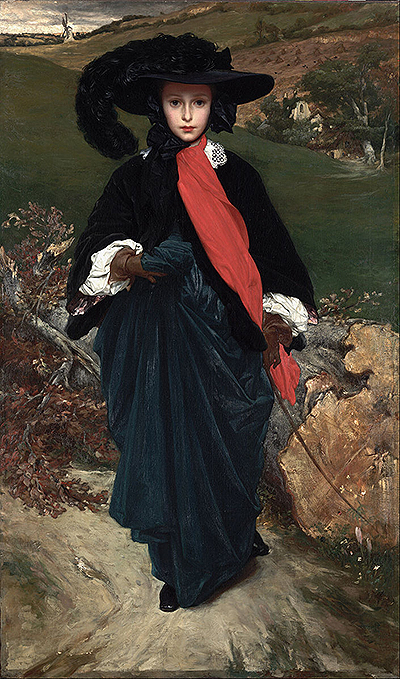Artist Fredric Leighton painted the Portrait of May Sartoris in 1860. Leighton met Adelaide Sartoris, mother to May Sartoris in 1853, Adelaide was a famous opera singer and hostess. Their friendship introduced him to the fashionable and artistic society. At around 1860, Leighton painted the portrait of May Theodosia, Adelaide's daughter, known as Portrait of May Sartoris.
Leighton was one of the leading artists that used the academism style of painting, a British art movement that was produced under the influence of European academies of art (see also the likes of Bouguereau). Leighton painting was solely on subjects that connected to roman mythology and ancient Greek. He intended to make his pictures visually beautiful. He used luminous colors, and his figures were solidly drawn. In his artistic works, he practiced the movements of Neoclassicism and Romanticism. He painted while emphasizing detailed drawing and elegance, which was essential in the neoclassical style.
The portrait of May Sartoris is at the Kimbell Art Museum displays. May was aged about fifteen, and the fallen tree represented the mortality over time. The painting depicted the setting of the family's residence in the countryside of Hampshire. The artwork was created using oil and canvas on a size that mimicked her actual life-size. Due to its size, the painting presents a focal point that is easy and quick to distinguish upon arriving at the museum. The brightest part in the picture is the color of her face and the darkest colored tones being in her clothing.
Upon viewing the painting, a person will immediately recognize the May Sartorius actual life-size standing in her well-painted attire in the foreground. Her attire is mainly black, with an additional dark blue. The only striking colorful item in the painting is the red sash worn around the neck hanging down to the waist. Her clothing has an implied soft texture, eluded by the sloping nature of her elegant dress, and a feather dawned at the top of her hat. To stay in harmony with portrait art, Leighton used organic shapes to emphasize the softness of the figure.
Leighton received his artistic training in Florence from Edward and Giovanni and later went to Paris, where he met Ingres and Corot. In 1860, Leighton settled in London, where he joined the Royal Academy as an associate and later was elected president in 1878. One of his early works that brought success in his artistic work was the Cimabue's Madonna. The painting portrayed Madonna being carried through the streets of Florence in procession. Leighton also influenced younger artists considerably, and one of the romantic painters influenced by him was John William Waterhouse.




